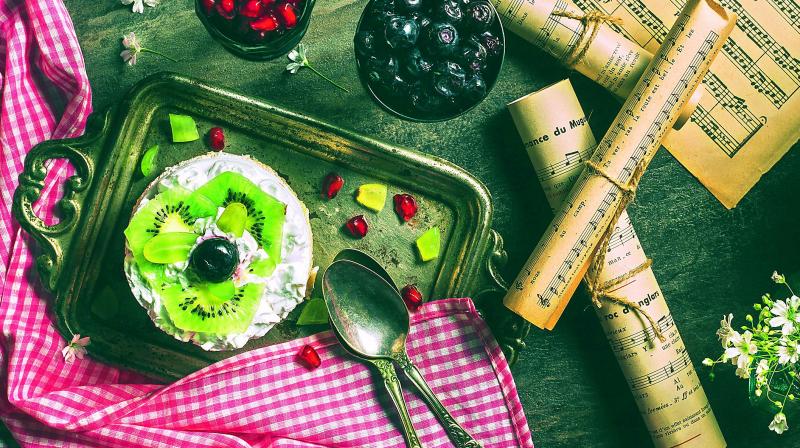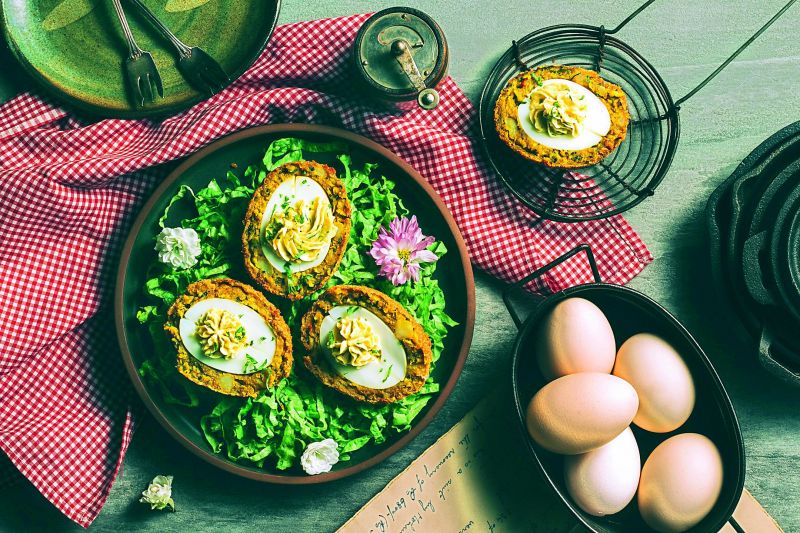A legacy of flavours
The flavors were exciting and the aromas enchanting, unlike anything they had ever tasted before.

Throughout the 18th and 19th Century, the British and other European settlers would often be enthralled by the spectacular assortment of food and spices from the myriad regions of the Indian subcontinent. The flavors were exciting and the aromas enchanting, unlike anything they had ever tasted before. But to be truly palatable to most British settlers, these centuries-old recipes needed to be ‘reimagined’ with a little bit of good old British flavour fundamentals. This lead to the foundations of what we now know as ‘Anglo-Indian’ cuisine, a hallmark of India’s culture of acceptance and co-existence.
Tipsy Pudding
Ingredients:
3 layers of sponge cake (300g), available in the market, or can be made at home too.
3 fluid ounces orange liquor (approx 85 grams)
Seasonal fruits (strawberries, grapes, banana, and orange), chopped in cubes
4 to 8 candied cherries (for decoration)
8 oz (approx 225 grams) heavy whipping cream
1 tbsp granulated sugar or 2 tbsp castor sugar
1/8 tsp vanilla extract
METHOD:
Place three layers of sponge soaked lightly in orange liquor. Sandwich the layers with fresh whipped cream mixed with strawberries, grapes, banana, and orange chunks. Top up with another layer of whipped cream and fruits. Use a strainer to dust the dish with castor sugar and decorate with cherries. Pudding is ready to serve.
The British mellowed down and anglicised certain Indian dishes with acceptable levels of spice and tweaked some of their signature English meals with Indian flavours, informs Ajit Singh, MD at Anglow, New Delhi. “The Anglo-Indian cuisine was relished in formal settings and on evenings when English sahibs, Indian Princes and bejewelled ladies would gather together to enjoy the finest whiskeys and wines, and the elaborate and extensive menus each night, prepared laboriously by the cooks were only outdone by others the next night. Their fare was honed to perfection at quintessential colonial institutions like gentleman’s clubs, railway kitchens, and Army messes,” explains Singh.
The Anglo-Indian cuisine is quite distinct from the regular Indian cuisine essentially because of its wide variety of ingredients. And even though the dishes are quite peculiar, they would never fade out because a number of Anglo-Indian dishes have now become staple Indian dishes, says Akshay Nayyar, head chef of Anglow.
“A number of authentic British dishes spiked with Indian flavours or Indian dishes with an addition or two of British ingredients and mellow spices is what makes this cuisine different. Anglo-Indian itself being a fusion cuisine doesn’t really have set recipes or ingredients for that matter. A number of Anglo-Indian dishes are made using the oven and it is almost impossible to make some of the most popular dishes without it. The British were the ones to get white bread, pastries, roasts etc to India, and now there are vegetarian variations of it in the cuisine,” says Nayyar, citing examples of some Anglo-Indian classics.
“A railway curry, for example, is made with either vegetables, mutton or chicken and sometimes even with cottage cheese. And the railway curry always differs in taste when had in Delhi, Kolkata or Chennai. Another really popular dish in Britain is Kedgeree. Open cheese toasts, shami kebabs and deviled eggs are an extremely popular choice in both the defence messes as well as a number of the colonial clubs in the country. Anglo-Indian dishes are by and large very easy to prepare at home and don’t usually require heavyweights in the kitchen to dish out. They also tend to have a very simple and delicate taste and are almost universally palatable,” he explains.
Chutneys were yet another amazing creation of the British and Indian cooks, and almost every dish from the cuisine is accompanied by a chutney, dip or sauce.
“The number of spices, herbs, and vegetables available in the Indian subcontinent made way for an amazing lot of side pickles and chutneys. Chutney itself is believed to have been invented by India in the years before Christ. But it had pretty much lost popularity after the fall of the Roman Empire.
The British started adopting chutneys and marmalades in their colonies to ration food and preserve it for longer durations. It is during this time, with the array of spices and ingredients available that this little side dish had a number of variations,” mentions chef Nayyar.
Like white bread, the British also brought in pastries, cakes and English desserts to India; essentially for their army and government officials. A number of Indian cooks learned the recipes and were tasked with dishing out cakes, puff pastries and a number of desserts like the tipsy pudding, caramel custard, fruit cream, bread pudding etc., mentions Singh, who curated the menu for Anglow after years of research on the cuisine.
“The desserts were an immediate hit even with the Indians and it wasn’t long before a number of people set up bakery shops in India. Even today, a number of Christian families in India prepare a plum cake on Christmas. Although it isn’t Anglo-Indian, it is a tradition introduced by the British that we embraced. The tipsy pudding is still a very popular dish in the Indian Defence messes and is served frequently after dinner. It's also one of the favourites for all the young NDA cadets,” he sums up.
 Deviled Scotch Eggs
Deviled Scotch Eggs
Deviled Scotch Eggs
Ingredients:
2 boiled eggs, cut into halves
2 medium sized mashed potatoes
100 gms chopped onions
1 tsp garlic powder
1 tsp paprika
100 coriander, chopped
Salt and pepper, as per taste
2 tbsp fried breadcrumbs for coating
METHOD:
Heat oil in a deep fryer to 350° F and cover the countertop with a large sheet of waxed paper. Mash the boiled potatoes and add chopped onions, garlic powder, paprika, chopped coriander, salt and pepper to the mash. Take a large chunk of mash in your hand and place an egg in the center. Enclose each egg completely in the mash.
Dredge the potato-coated eggs in flour, dip them in the raw egg and then roll them in the bread crumbs until they are entirely coated. Fry Scotch eggs two at a time for 5 minutes. Transfer them to paper towels and allow them to cool. To devil them, halve the Scotch Eggs lengthwise and remove the yolks. Mash the yolks with a fork and then place them in the bowl of a stand mixer. Add the mayonnaise, mustard, salt, and pepper and mix until smooth. Using a pastry bag or sandwich bag with an end snipped off, pipe the yolk mixture back into the Scotch Eggs.
Lamb Barley Pot
Ingredients:
100 gms pot barley (boiled)
3 medium onions, chopped
1 tsp Worcestershire sauce for marinating
1 tsp of lime juice for marinating
Chili flakes, as per taste
10 gms mustard Seeds
8 pieces of lamb chops
500 ml water or stock to cover
A thin sheet of rolled out flour to cover
Salt and freshly ground black pepper, as per taste
METHOD:
Marinate lamb in garlic, Worcestershire sauce, lime, salt, and pepper overnight. Roast the lamb in the oven for about 20 mins at 350 degree Fahrenheit. Add the mutton to an oven friendly dish. Add boiled barley, mustard seeds, chili flakes, onions and stock to the mix of Indian spices along with salt as per taste. Cover the dish with a thin sheet of rolled out flour. Bake in the oven for 15 minutes at 350 degree Fahrenheit till the mutton is soft. Serve hot.

